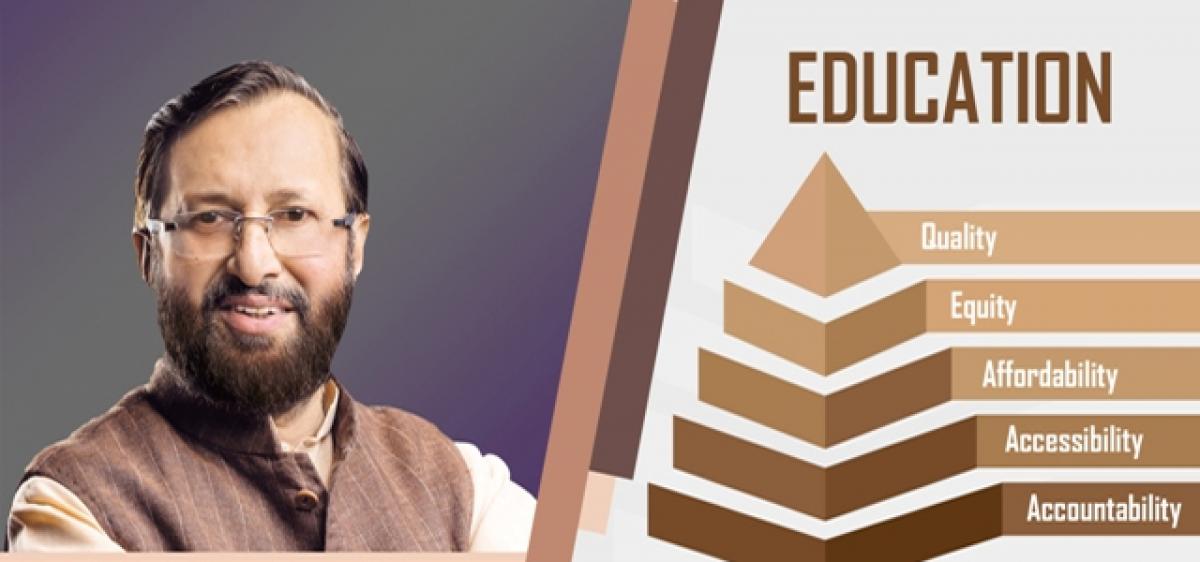Live
- Private practitioner found operating from govt clinic
- PM stresses on thinking out-of-the-box in every sector
- Lokayukta cracks down, seizes illicit assets worth crores
- Farmers protest over delay in canal repair
- Amid continuing furore, five more maternal deaths occur in State
- Fostering a robust innovation
- New AP tourism policy hailed
- Village that gave land for Suvarna Vidhana Soudha, a picture of apathy
- What’s The Matter At Hand?
- Pollution levels continue to soar in Yamuna
Just In

The All India Survey on Higher Education (AISHE) Report for the year 2016-17, released recently, shows gains in gross enrollment and gender parity in higher education.
The All India Survey on Higher Education (AISHE) Report for the year 2016-17, released recently, shows gains in gross enrollment and gender parity in higher education. However, concerns remain about the employability of India's graduates. Not being able to attract the best talent is one thing, but employing ghost teachers for fake courses is another problem.
The upcoming Budget is bound to focus on certain issues. The Survey showed us that 3.4 million new students were added to the higher education pool between 2014-15 and 2016-17, data from the Human Resources Development Ministry shows. This poses a new challenge to the Union government. The ruling party has promised jobs to the youth and is now facing the criticism that it has failed on this front.
This factor has become an electoral challenge to it, too, with disenchantment among the youth growing. It is certainly a welcome news that the gross enrollment ratio (GER) has improved to 25.2 (which means around 25 of every 100 eligible candidates go for higher education). But, the bad news is that all these youths would hit the job market soon and need jobs.
Quality factor steps in because the industry is not ready to absorb the entire pool as it is not an industry-ready group, leading only to increased unemployment. In 2016-17, according to reports, more than 40,000 colleges, 11,669 stand-alone institutions and 864 universities existed in the country. Back in 2010-11, the number of colleges was 32,974 and that of universities was 621.
On an average, 40 universities and over 1,150 colleges had been added in the past six years. The country had 35.7 million higher education students in 2016-17 compared to the 32.3 million a couple of years ago. This phenomenon also coincides with under-staffing problem in the educational institutions. In fact, the number is growing up in comparison to the students.
In 2016-17 there were 1.37 million teachers as against 1.52 million the previous year. The HRD Minister, Prakash Javadekar, had noted with concern that about 15 per cent of the teachers on the rolls in 2015-16 did not show up in the survey now. Perhaps, this is an indicator that the figures have been fudged by the institutions.
According to the Minister, 80,000 teachers could face action – i.e., if they exist. Again, the survey pointed out that for every 100 male students, the number of the female students was 92.
Though the Prime Minister recently declared that a competition to identify 20 Indian universities that have the potential to become 'world-class' would be held in order to improve the standards, and lend financial support to them and unshackle them from regulations and restrictions, the fact that across the country 40 per cent faculty positions remain vacant does not augur well for any knowledge society.
Funding for education is only a small percentage of India's GDP compared to nations whose institutions inhabit the top 500 world rankings. It must also be noted that top universities also need autonomy to flourish, but our country has a history of restrictive over-regulation. Appropriate skill-sets, stopping commercialisation and adequate funding are the need of the hour. Hope the government wakes up!

© 2024 Hyderabad Media House Limited/The Hans India. All rights reserved. Powered by hocalwire.com







